|
Many years ago Canadian Pacific Railway (CPR) stations housed an
Operator or Agent.
The Agent was a better paying job but carried more duties than an Operator. The operator had a desk or counter top on
which to work, usually located in the bay window of a station. Here he was in communication with the Dispatcher by
telegraph. Over the passing years telephone and radio communications were established. Today, Agents and Operators are
long gone but some stations are now connected to the company's computer network.
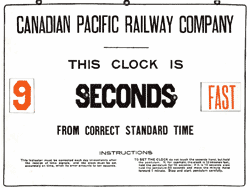 Trains were operated
following a timetable which gave great importance to time and adherence to schedule. Each day a precise time signal was
broadcast by telegraph from headquarters in Montreal to each station on the system. Station Operators would ensure their
station clocks were set as close as possible to this published time
signal. CPR typically used pendulum clocks manufactured by the World Clock Company. These could be set within half a
second of the published time signal by adjusting the pendulum. The number of seconds each clock varied from published
time was placarded on the wall beside the clock, so many seconds, plus or minus the published time. Trains were operated
following a timetable which gave great importance to time and adherence to schedule. Each day a precise time signal was
broadcast by telegraph from headquarters in Montreal to each station on the system. Station Operators would ensure their
station clocks were set as close as possible to this published time
signal. CPR typically used pendulum clocks manufactured by the World Clock Company. These could be set within half a
second of the published time signal by adjusting the pendulum. The number of seconds each clock varied from published
time was placarded on the wall beside the clock, so many seconds, plus or minus the published time.
Running Trades (Conductor, Engineer, Fireman, Brakemen, Trainmen, etc.) were required to carry a pocket watch
approved by the company and inspected by CPR certified jewelers on a periodic basis. At specified stations train crews
were required to compare their personal watches with the time on the station clock and with each other. All this, just
to determine their train's location according to a timetable schedule. Time was all-important in keeping trains
separated to avoid collision.
 Dispatching DispatchingThere are inherent dangers with time operation. What happens if a train is delayed, stalled, or somehow breaks down
on the road? This is where the telegraph provided safety with a method of controlling trains by Train Orders. A
Dispatcher could sit at some central location and "dispatch" trains by issuing instructions via the telegraph.
Today's Dispatchers, known as RTCs, (Rail Traffic Controller) authorize train movements with much more positive control
through the use of CTC (Centralized Traffic Control), but that is another story. Train Orders evolved into regular forms
that were given numbers to identify typical content. Train Orders include such things as fixing meeting points for
opposing trains, directing a train to pass or run ahead of another train, granting rights over an opposing train, time
orders, extra train orders (An extra train is one not listed in the timetable.), holding orders, speed restrictions, and
annulling a previously issued order.
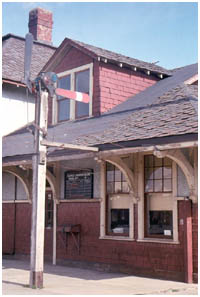 So, the Dispatcher was located in his fixed position, transmitting these orders via
telegraph to Operators along the line of railway. Upon receipt of an order how did the Operator pass it along to a
train? So, the Dispatcher was located in his fixed position, transmitting these orders via
telegraph to Operators along the line of railway. Upon receipt of an order how did the Operator pass it along to a
train?
This is where the Order Board came into play. The typical CPR Order Board was a semaphore
signal mounted on a mast by the station or on a wooden support structure on the station's roof. Cables ran from the
semaphore blade mechanism via pulleys into the Operators bay. In the simplest method there was a hook mounted on the
wall and the Operator simply pulled a handle and placed it on the hook. Removing the handle from a hook would permit the
blade to fall into the horizontal position. A more sophisticated version utilized a handle, gears, rods, and bell crank
arrangement as shown in the photo.
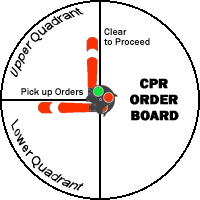 Note: The CPR Order Board is what is known as an upper quadrant semaphore. That is, it swings between the
vertical and horizontal position when facing the coloured portion of the blade, the reverse side is black and has no
meaning. Each station required two semaphores, one for each direction. Initially semaphore signals utilized the lower
quadrant range (horizontal to vertical) with a horizontal blade indicating "stop". This arrangement was not
"fail safe". Picture the result if a cable should break. The horizontal blade would drop to the "Clear to
Proceed" position. If a cable were to break in an upper quadrant signal the weight of the blade would cause it to
fall to the safer restrictive horizontal position rather than giving a "Clear to Proceed". (In Britain upper
quadrant semaphores are still in use on heritage lines. They overcame the "fail safe" problem by adding a
counter weight to the blade so a failure would cause the blade to fall to the most restrictive or stop position.)
Note: The CPR Order Board is what is known as an upper quadrant semaphore. That is, it swings between the
vertical and horizontal position when facing the coloured portion of the blade, the reverse side is black and has no
meaning. Each station required two semaphores, one for each direction. Initially semaphore signals utilized the lower
quadrant range (horizontal to vertical) with a horizontal blade indicating "stop". This arrangement was not
"fail safe". Picture the result if a cable should break. The horizontal blade would drop to the "Clear to
Proceed" position. If a cable were to break in an upper quadrant signal the weight of the blade would cause it to
fall to the safer restrictive horizontal position rather than giving a "Clear to Proceed". (In Britain upper
quadrant semaphores are still in use on heritage lines. They overcame the "fail safe" problem by adding a
counter weight to the blade so a failure would cause the blade to fall to the most restrictive or stop position.)
When the Operator received an order for a train from the Dispatcher he would transcribe the order to the appropriate
paper form. He then set the Order Board to the horizontal position indicating to the train's head-end crew there was an
order to be picked up. The train did not have to stop to receive the order but needed only to slow for it to be passed
(hooped up) to the Engineer and Conductor. The Operator attached the paper order to a hoop made of wood bent into a
"P" shape. The Operator would prepare two hoops then stand on the station platform during a train's approach.
Holding the bottom part of the hoop the Operator would extend the loop portion high enough for the Engineer or Fireman
to insert his arm into the loop taking it as the train passed. The Engineer or Fireman would remove the paper order and
drop the hoop back on the ground. This was repeated for the Conductor riding the caboose. (One wonders how the Operator
enjoyed retrieving hoops from some prairie platform during winter temperatures of -30 degrees as a train whistled past.
Was he a little stiff on the telegraph key after this?).
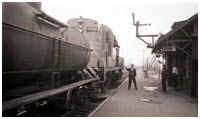 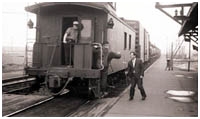
Hooping up orders to a train at Dorval, Quebec - March 1967 Kevin Day.
|